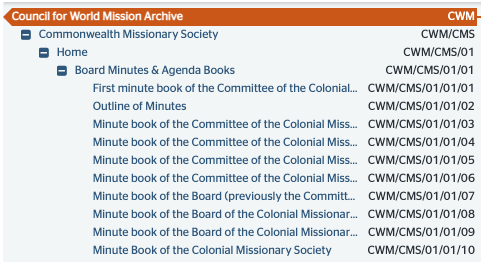Archive Descriptions
An Introduction to Archive Descriptions
Archives are unique collections, and cataloguing practices may vary between institutions, so descriptions on the Archives Hub will look similar, but vary in the level of detail they provide.
Sections of an Archive Description
Descriptions include core sections that are common to all entries and additional sections that may be included in some descriptions but not in others.
Descriptions may be just a single level, which summarises the whole collection, or a whole hierarchy that typically comprises an overall description together with 'lower levels' that provide nested levels such as series, sub-series, and items.

If a colletion has a hierarchy it is known as a multi-level description and it will have a tree structure that you can navigate, listing all of the described sections within a collection.
A lower level entry, such as a series or item description, that forms just one part of a complete collection description, may be brief, sometimes only with a reference, title and date. The title may not make much sense unless it is viewed in the context of the whole description

The Campaign Notes described here only make sense when viewed in the context of the whole description - Colne Valley Labour Party Archive.
The key sections of an archive description are:
Reference Number: The reference used to describe the collection, often a combination of letters and numbers, such as 'MGF'.
Title: The title of the collection, intended to give an overall sense of what the collection is and who created it, e.g. British Olympic Association Archive Collection, or Papers of Millicent Garrett Fawcett. At lower levels the title may be something like Account Book or Baptism Register or just Letter. These need to be viewed in the context of the whole description.
Dates of Creation: The covering dates of the material, from the oldest to the most recent item within the collection. Typically something like '1900-1952', or maybe more specific, such as 'January 1914 - March 1915'. Sometimes dates will be more approximate, such as 'Early 19th century'. At item level the date will be specific to the document.
Language: The language of the collection, often English, but may be in any language, or a combination of languages. Some collections are in several languages, sometimes quite obscure ones! Language is not always given for items, but it is more likely to be provided if the language differs from the main language of the collection.
Physical Description: The size of the collection, often given as the number of boxes or a measurement in linear or cubic metres. Other information may be included here such as types of materials, physical condition and dimensions. For items, you may get the specific dimensions, genre or physical characterisics.
Scope and Content: A description of the overall contents of the collection, which may be brief or very detailed. It may list all the series within the collection.
Arrangement: The way the archive is organised, which may include a list of the series within the collection.
Adminstrative/Biographical History: Information about the creator of the archive. For example, a biography of Millicent Garrett Fawcett or a description of The National Union of Women's Suffrage Societies.
Conditions Governing Access: May include important information about access, such as whether the collection is fully open for consultation and whether you need to make an appointment.At lower levels there may be information about items that are closed due to data protection issues or fragility.
Subjects / Personal Names / Corporate Names / Geographic Names: These are 'index terms' added by the creator of the description. They are significant people, organisations, subjects and places associated with the archive. On the Archives Hub they are clickable links, to take you to more archives that relate to the same topic area. They are most typically added at the top level, but sometimes provided at lower levels, e.g. correspondents within a series of letters.
Other Information
Other descriptive information may be provided such as information about separated material (which shares the same provenance, but became separated over time), reproduction (whether the material can be copie) and the proveance and history of the material. If the material is copies, the location of the originals may be given.

The first part of a collection description, showing the 'core information' and the 'scope and content' section.

An 'item level' description, showing the breadcrumb trail that leads back to the main collection description.
This page is part of: Using Archives: A Beginner's Guide

